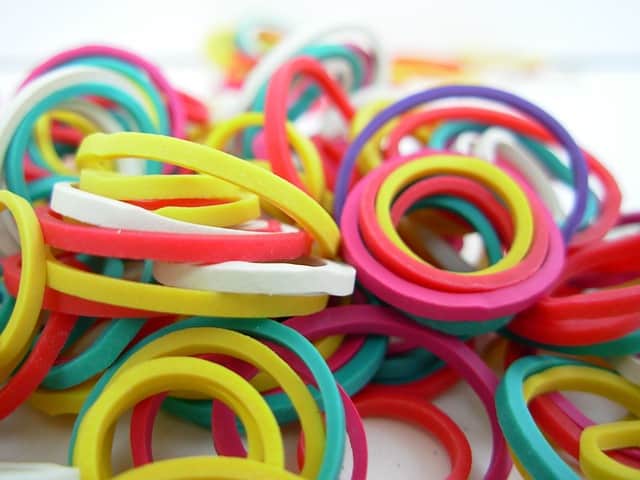If you’re considering or have decided to use braces to straighten your teeth, one of the most important aspects of this treatment is the use of what are known as orthodontic elastics, which are basically rubber bands. These elastic bands may seem like a small part of your treatment. But in reality, they play an integral role in straightening your teeth and making sure that they move into the optimal position. If you don’t wear them, they can delay or even prevent the straightening of your teeth, which is something that no one wants.
What are Orthodontic Elastics?
Depending on the direction in which your teeth need to be straightened or moved, small rubber bands known as orthodontic elastics will be placed around certain brackets on both the upper and lower teeth as a means of applying forces that will move your teeth into place. Over a period of time, these elastics will correct an improper bite, which is considered to be the most time-consuming portion of teeth straightening.
For instance, if you suffer from an overbite, elastics that are connected to brackets or clear aligners (such as Invisalign) will gradually move the upper teeth to their correct position. Although these elastics are usually of a similar color as your teeth, they are available in a wide array of color options. Current best practices dictate that elastic wear begins early in treatment to maximize tooth movement and facilitate faster treatment times. Failure to follow your orthodontist’s recommendations for elastic wear will likely result in increased time in braces, and an incomplete correction of the bite. If for no there reason, this should be incentive enough to wear your elastics as prescribed by the orthodontist.
Elastics are very strong, durable, and highly flexible. This means that you can talk and move your mouth with general ease and only a small amount of resistance. You will be provided with a large number of rubber bands. You don’t have to return to the orthodontist every time one breaks or you lose one. In general, they need to be replaced every 12 hours. The elasticity decreases beyond this time, therefore limiting their effectiveness unless fresh elastics are placed in the mouth.
How These Elastics Work
The way that these elastics work all depends on how they are being used and where they are being placed. In general, they work by being placed over two areas of your brackets or aligners in order to move those areas into proper alignment. They will typically push your jaw backward or forwards depending on the corrections that need to be made. The primary goal is for your upper teeth and lower teeth to touch when you bite down. These elastics work slowly, which is why they start being used early in treatment.
These rubber bands act as an addition to the straightening that’s already occurring with the brackets or aligners that are currently placed on your teeth, allowing you to finish treatment earlier than if you had solely used the brackets or clear aligners. In almost all cases, elastics must be work 24 hours a day, 7 days a week to achieve the desired effect from their wear. There are exceptions to this rule, but those exceptions are rare. The only time the elastics should be taken out are when you brush and floss your teeth, or when you are eating.
It’s essential that you wear these bands exactly how you are told to wear them. Wearing them for longer or shorter periods of time than required could cause a variety of adverse effects. Likewise, some people attempt to “double up” their bands in order to speed up treatment. Please do not attempt this, as it places an undue amount of force on your teeth. Side effects could include tooth mobility or damage to the roots and gums.
Here’s the Kicker
When this occurs, the teeth don’t move into their proper position more rapidly but can instead be damaged along with the root of the tooth, which would require additional treatments to correct. Immediately after you start using these elastics, you will likely feel a small amount of discomfort and pain. But this pain should go away quickly as you start to get used to additional force around your teeth. If the pain doesn’t subside in a few days or actually worsens, don’t hesitate to stop by your orthodontic office to have your teeth looked at.
Importance of Orthodontic Elastics
There are a wide array of benefits provided to your teeth and the teeth straightening process when you wear orthodontic elastics. These elastics are designed to assist bite correction when wearing braces or clear aligners by pushing your teeth into their proper position quicker than otherwise would be possible. In almost all cases, not properly wearing your elastics means that you will need to wear your teeth straightening appliance for a lengthier period of time, and likely will not achieve the quality orthodontic result that you or your orthodontist desires.
Given the stretchy and flexible nature of these elastics, you will still maintain full range of motion in your mouth. Allowing you to talk, eat, and yawn with ease. These rubber bands are also easy for you to remove and replace. They readily hook up to the brackets or aligners in your mouth without much issue. Orthodontic elastics is that they are highly versatile in what they can be used for.
Although the primary issues that these elastics are designed to correct include underbite and overbite problems, they can also help to correct issues that have resulted in a cross-bite or open bite, allowing you to use them for a wide range of orthodontic problems. When these items are being used, make sure to replace them every 12 hours. This is to ensure that the strength and elasticity don’t lessen when wearing them, which could hinder the effectiveness of your treatment.
Want to Know the Best Part
If you have teeth that need to be straightened and wish to explore your options, call Dr. Nease now at Nease & Higginbotham Orthodontics to get started.
Contact Dr. Nease and he will guide you through the details and you will walk away with a smile you can be proud of!
Spartanburg Office
2455 E. Main Street
Spartanburg, SC 29307
Phone: (864) 579-7700
Orthodontic Elastics (Rubber Bands) What And How?




